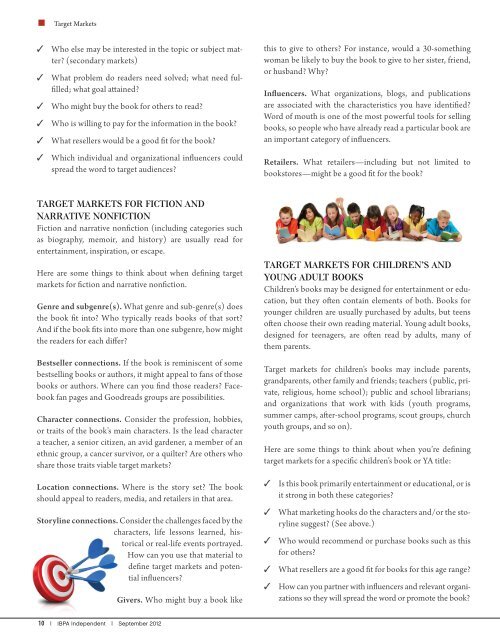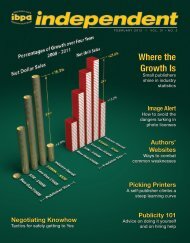Book- Business Lingo
Book- Business Lingo - Van-garde
Book- Business Lingo - Van-garde
You also want an ePaper? Increase the reach of your titles
YUMPU automatically turns print PDFs into web optimized ePapers that Google loves.
■ Target Markets✓✓✓✓✓✓Who else may be interested in the topic or subject matter?(secondary markets)What problem do readers need solved; what need fulfilled;what goal attained?Who might buy the book for others to read?Who is willing to pay for the information in the book?What resellers would be a good fit for the book?Which individual and organizational influencers couldspread the word to target audiences?this to give to others? For instance, would a 30-somethingwoman be likely to buy the book to give to her sister, friend,or husband? Why?Influencers. What organizations, blogs, and publicationsare associated with the characteristics you have identified?Word of mouth is one of the most powerful tools for sellingbooks, so people who have already read a particular book arean important category of influencers.Retailers. What retailers—including but not limited tobookstores—might be a good fit for the book?Target Markets for Fiction andNarrative NonfictionFiction and narrative nonfiction (including categories suchas biography, memoir, and history) are usually read forentertainment, inspiration, or escape.Here are some things to think about when defining targetmarkets for fiction and narrative nonfiction.Genre and subgenre(s). What genre and sub-genre(s) doesthe book fit into? Who typically reads books of that sort?And if the book fits into more than one subgenre, how mightthe readers for each differ?Bestseller connections. If the book is reminiscent of somebestselling books or authors, it might appeal to fans of thosebooks or authors. Where can you find those readers? Facebookfan pages and Goodreads groups are possibilities.Character connections. Consider the profession, hobbies,or traits of the book’s main characters. Is the lead charactera teacher, a senior citizen, an avid gardener, a member of anethnic group, a cancer survivor, or a quilter? Are others whoshare those traits viable target markets?Target Markets for Children’s andYoung Adult <strong>Book</strong>sChildren’s books may be designed for entertainment or education,but they often contain elements of both. <strong>Book</strong>s foryounger children are usually purchased by adults, but teensoften choose their own reading material. Young adult books,designed for teenagers, are often read by adults, many ofthem parents.Target markets for children’s books may include parents,grandparents, other family and friends; teachers (public, private,religious, home school); public and school librarians;and organizations that work with kids (youth programs,summer camps, after-school programs, scout groups, churchyouth groups, and so on).Here are some things to think about when you’re definingtarget markets for a specific children’s book or YA title:Location connections. Where is the story set? The bookshould appeal to readers, media, and retailers in that area.Storyline connections. Consider the challenges faced by thecharacters, life lessons learned, historicalor real-life events portrayed.How can you use that material todefine target markets and potentialinfluencers?Givers. Who might buy a book like✓✓✓✓✓Is this book primarily entertainment or educational, or isit strong in both these categories?What marketing hooks do the characters and/or the storylinesuggest? (See above.)Who would recommend or purchase books such as thisfor others?What resellers are a good fit for books for this age range?How can you partner with influencers and relevant organizationsso they will spread the word or promote the book?10 | IBPA Independent | September 2012








